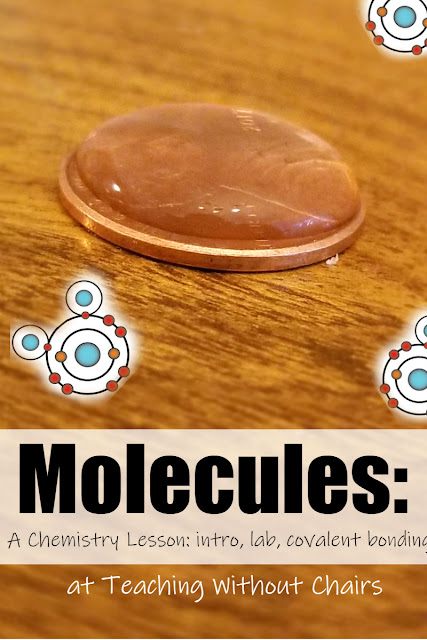Chemistry Class - Molecules Intro - Homeschool Science Chemistry
This is the fifth lesson in the homeschool science Chemistry Class I am putting together for elementary and middle school aged students! Today's topic is Molecules! Click HERE to see all the other lessons too!
Today we are going to learn one way atoms combine to form molecules, experiment with the effects of covalent bonds in water, and talk about a few common molecules made with covalent bonds.
Supplies:
* cup
* water
* paperclips
* optional: penny, pipette, and water
Goals:
At the end of this lesson, students will be able to...
1- Explain what a molecule is.
2- Explain what a covalent bond is.
3- Give an example of a molecule held together by covalent bonds.
4- Tell how many and which atoms are in a molecule if they are given the molecules chemical formula.
3- Give an example of a molecule held together by covalent bonds.
4- Tell how many and which atoms are in a molecule if they are given the molecules chemical formula.
Lesson:
Read: We're going to start with an experiment today! Fill a cup right to the brim with water. You may want to leave it in the sink or set it in a shallow pan.
Now we're going to start putting paperclips into the full cup of water. How many paperclips do you think it will hold? Write down your hypothesis, and let's test it! Carefully slide a paperclip into the cup full of water. Keep adding paperclips until the water spills over the edge!
Fill a cup with water and see how many paperclips you can add!
Read: Did you notice how the water seemed to bulge over the top of the edge of the cup? Water molecules are held together by covalent bonds, which makes them act sticky!
Remember from our second lesson that electrons orbit an atom's nucleus in energy levels. The first energy level can hold two electrons. Hydrogen only has one electron, so it has room for another one. If you bring two hydrogen atoms near each other, like in the image below, their electrons will start orbiting the two nucleuses together!
This will bind the two hydrogen together in a very stable molecule. In fact, hydrogen is very rarely found all by itself in nature. It is usually attached to another hydrogen or another atom that has room for one more electron!
We call this bond, formed from atoms sharing electrons, a covalent bond. It creates a molecule, or a group of two or more atoms bound together. (We are going to look at covalent bonds today and tomorrow, then we will discuss ionic bonds the next day.)
This brings us back to our experiment: why does the water seem to stick to itself?
To answer this we have to look at where the electrons are in the water molecule.
The chemical formula for water is H2O, meaning that each molecule of water has two hydrogens and one oxygen. We can look up what letters represent each element on the periodic table.
Each hydrogen atom has one electron in its little energy level and the larger oxygen has eight electrons (two in the inner energy level and six in the outer energy level), as seen in the image below:
The oxygen can fit two more electrons in its outer energy level, and then it will be "full" (remember that the second energy level can hold eight electrons). A covalent bond will hold the two hydrogen onto the oxygen: the electrons from the hydrogen will orbit both the hydrogen and the oxygen and the electrons from the oxygen will orbit the hydrogen (two at a time).
Obviously the electrons will spend more time orbiting the larger oxygen "end" of the water molecule. They will cruise around the smaller hydrogen much faster, both because it is smaller and because it only has room for two electrons at a time. This will create a charge on the water molecule...since the electrons have a negative charge, the oxygen side of the water (where the electrons spend more time) will be slightly negative and the hydrogen side of the water molecule will be slightly positive, as illustrated in the image below:
Just like the positive end of a magnet will stick to the negative end of another magnet, the positive end of a water molecule will "stick" to the negative end of another water molecule, forming a huge network of water molecules that are inclined to stick to each other, as illustrated below:
The attraction between positive and negative ends of water molecules is strong enough that they will stick to each other even if that means forming a bulging pile of water above the edge of a cup!
Another fun way to see this in action is to take a penny and a pipette and see how many drops of water you can fit on the penny! If you're careful you will see the water piling up above the edge of the penny too!
Water is an exciting example of covalent bonding because the electrons are shared unevenly by the oxygen and hydrogen. It creates a polar (or charged) molecule.
Other times the electrons are shared evenly: for example, in hydrogen (H2) the electrons spend equal amounts of time orbiting each hydrogen atom. There is no charge on a hydrogen (H2) molecule.
Carbon dioxide (CO2) is another molecule held together by covalent bonds. It is very important in plants because it is absolutely necessary for the plants to make food through photosynthesis. Humans and other animals also exhale, or breathe out, carbon dioxide. Carbon dioxide is not a charged molecule either.
Review/Final Discussion:
1- What is an atom?
2- What is a molecule?
3- What is a covalent bond?
4- Give an example of a molecule held together by covalent bonds?
5- The chemical formula for water is H2O. How many hydrogen atoms are in each molecule of water? How many oxygen atoms?
6- The chemical formula for glucose (a type of sugar) is C6H12O6. How many hydrogen atoms are in a molecule of glucose?
7- How many hydrogen atoms are in two molecules of glucose (written 2C6H12O6)?
***
4- Give an example of a molecule held together by covalent bonds?
5- The chemical formula for water is H2O. How many hydrogen atoms are in each molecule of water? How many oxygen atoms?
6- The chemical formula for glucose (a type of sugar) is C6H12O6. How many hydrogen atoms are in a molecule of glucose?
7- How many hydrogen atoms are in two molecules of glucose (written 2C6H12O6)?
***
This is the fifth lesson in my Atoms & Molecules Chemistry Class for homeschoolers! Click HERE to get the rest!
And if you're looking for more homeschool unit studies, be sure to check out our growing collection here!
Happy Educating,
Carla & the kids who don't sit still!
Here is the printout for the subatomic particles!
Here is the printout for the edible atoms!
And if you're looking for more homeschool unit studies, be sure to check out our growing collection here!
Happy Educating,
Carla & the kids who don't sit still!



























0 comments